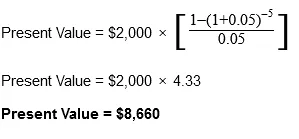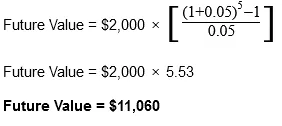Annuity Factor
The annuity factor definition is the use of a financial method that shows the value, present or future, of an amount when it is multiplied by a periodic amount. The calculation of an annuity factor requires the number of years involved, or the periodic amount, and the percentage rate applicable. The most often used for annuity factors are investments with either or both an annual payment or return. Typical examples of annuity factors being applied are savings accounts, certain types of insurances, or retirement savings plans.
The annuity factor meaning is a particular type of accumulating discount factor used to determine the present or future value of annuities, as well as equated installments. Another name for annuity factors is the annuity formula, and we’ll get into that momentarily.
The Present Value Annuity Factor
The present value annuity factor allows you to determine the amount of money required at the present time in order to result in a future series of payments assuming a fixed interest rate is applied.
In order to reach the present value annuity factor, a formula is used that discounts a future value amount to the present value amount through the use of the applicable interest rate. The period of time during which the investment will last is also taken into account to reach the correct value.
The Present Value Annuity Formula

With:
C=cash flow per period
i = interest rate
n = number of payments
The Future Value Annuity Factor
The future value annuity factor gives access to the final return value of a series of regular investments taking into account their worth at a future time, usually at the end of the investing period, assuming that a fixed interest rate is applied.
To reach the future value annuity factor, the formula above is slightly altered in order to add the values collected over the years by also accounting for the set interest rate.
The Future Value Annuity Factor

With:
C=cash flow per period
i = interest rate
n = number of payments
Applying the Annuity Factor formulas:
Considering an investment with an annual $2,000 payment over the course of five years at an interest rate of 5%, let’s see what the present and future value would be.


The previous formulas can help you determine the present and future values of ordinary annuities. While the math might seem complicated, there are financial calculators online that can help you out with the correct inputs and data.
Popular Real Estate Terms
Derogative term describing a high-pressure telemarketing office where sales personnel often use extremely exaggerated claims as well as intense sales practices to convince targets clients ...
Unfortunately, we encounter false advertising daily. False advertising refers to deceptive or misleading ads and commercials that fail to showcase a product’s or service’s ...
Type of ownership by husband and wife, recognized in 27 states, in which the rights of the deceased spouse pass to the survivor. It is the same as joint tenancy, except that one spouse ...
Platform erected on a roof in some New England homes having a view of the sea. It was said widows of lost seaman would walk on the platform looking out at sea for their husbands to return ...
One who has committed a tort. A tort is a civil wrong that occurs as a result of a breach of legal duty owed to someone, e.g., negligence. A tort does not arise from a breach of contract. ...
A purchase of real property made on account. Loan extended to business or individuals to buy real estate. In taxation, a dollar-for-dollar reduction in taxes. An example of a tax ...
The tenant is forced to leave the premises if he complains about the poor condition of the apartment or office space he has leased. This type of eviction is illegal in many states. ...
Descriptive of the architectural development of property in a certain area. For example, a housing subdivision may use very similar building architecture throughout the development. All the ...
Balcony or low ceiling overhang just above the main floor and between the next story. In a theater, a mezzanine is the first balcony above the stage. ...
Have a question or comment?
We're here to help.